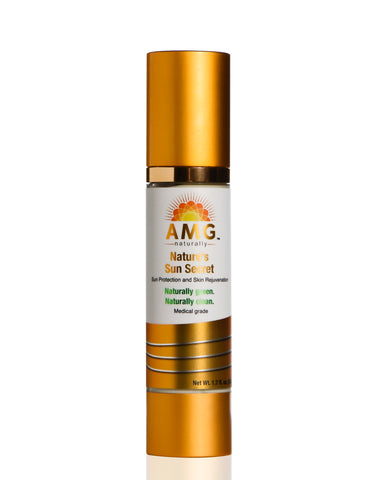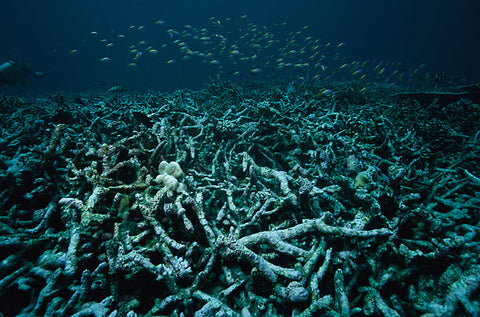
Negative Effects of
Chemical Sunscreens on
Our Oceans’ Coral Reefs

The last two AMG Newsletters were about the negative health effects of many of the synthetic ingredients found in “chemical sunscreens”. Mineral based sunscreens are slightly healthier, but often do not work (burning occurs) especially if not reapplied every hour.
Why does Mother Nature know best.
Believe it or not, the best infrared (IRA) protectors against the sun’s negative effects are antioxidants as well as SPFs found in fruits and vegetables (plants). Chances are, way back in the day, people got red from being in the sun for too long but ate coconuts, pineapple and multi-colored vegetables – those that one could pick off a tree or bush, which contained multiple vitamin (A,C,E) and polyphenol antioxidants (such as blackberries and pomegranate), without developing skin cancer.
Back up 50 years ago, one of the most successful companies making sun lotions was HAWAIIAN TROPIC. When they started they claimed their original lotions/oils were not “proven” sunscreen. To me, that means at that time, they did not meet the FDA requirements which I have learned is not the “be all end all”. In this day and age, we need to be our own private detectives if we want to be in control of our health. To meet current FDA requirements, a sunscreen MUST use multiple chemical SPFs. FDA also accepts 2 mineral SPFs that we are all aware of: titanium dioxide and zinc oxide. The FDA also accepts nano zinc oxide and nano titanium dioxide. Nano makes the particles so small that they can get absorbed deep, too deep, even into the DNA. That sunscreen won’t be white and ugly while sitting on your skin, but at what cost to your health? Like GMO, this will turn out to be a disaster for the health of many. That could be a future whole newsletter.
Nature’s Sun Secret that I created, (disclaimer: God created the plants, I just put them together) is a combination of plant antioxidants, plant SPFs from many plant oils, as well as added antioxidants; vitamins C, E and beta carotene. In 2010, a researcher published an article saying “The increasing incidence of skin cancer despite the use of externally applied sun protection strategies, alongside research showing that nutrients reduce photo-oxidative damage, suggest nutritional approaches could apply a beneficial role in skin cancer prevention.”

{Reference: Shapira N. Nutritional approach to sun protection: a suggested complement to external strategies. Nutr. Review. 68 (2):75-86.}
Professor Clarke, an orthopedic surgeon at the University of Southampton, observed and then warned that parents covering children in sunscreen has led to the reemergence of rickets. Clarke says, “20% have bone problems because of low vitamin D, lack of exposure to sunshine and covering up while in sunshine is to blame.” Rickets is a classic vitamin D deficiency that causes bowed legs.
Is melanoma really caused by the sun?
A study on U.S. Navy personnel indicates that those that worked inside had a higher incidence of melanoma compared with those that worked outside. More melanoma was found on the trunk of the body and we know what uniforms they wear. Do we really know what causes melanoma? In a prior AMG newsletter we talked about how organ transplant patients taking drugs to prevent organ rejection commonly get melanoma while in the hospital. That’s a hard one to understand.
Now I suggest we look beyond ourselves and see what damage mankind is doing to nature via some specific synthetically made chemicals that are commonly consumed through the skin. Since we are talking about the sun and sunscreens, let’s focus on everyone wearing sunscreens before they swim in the oceans with their kids (and their dogs).We know the water will wash off the sun lotion. FDA guidelines state people must reapply every hour and directly after swimming and sweating…so if it is hot out…basically re-slather every hour no matter what you are doing.
I personally love scuba diving, snorkeling and swimming in the ocean. I am concerned about destruction of the oceans’ coral reefs. Coral appear as hard, rock-like structures, but they are actually a collection of polyps, small marine creatures that live together in colonies, which fuse their skeletons together to create a reef. According to a recent estimate made by NOAA, the National Oceanic and Atmospheric Administration, “about a quarter of all marine life in the ocean reside in coral reefs,” making it one of the planet’s most diverse and extensive ecosystems. Their hard outer shells are composed of calcium carbonate, also known as limestone. Carbon dioxide from the water joins with calcium to make this calcium carbonate. Millions of corals from many different species make up a reef. Corals exist in shallow tropical water, 120 feet in depth or less, because they require sunshine for their survival. Scientists are super concerned about rising occurrence of coral bleaching, resulting in widespread destruction.

Algae provide the beautiful colors seen in coral reefs. A temperature and chemically sensitive photosynthetic algae called Zooxamthellae lives within coral’s transparent membranes. Why? Because of perfect symbiosis. The algae need the sun for photosynthesis and carbon dioxide while the coral needs the oxygen and nutrients provided by the algae including oxygen, glucose, glycerol and amino acids.
Why would the algae ever leave? What causes algae to die? When algae leave or die the coral loses its color and capacity to receive nutrients. Scientists call this “coral bleaching.” Since the coral needs the algae to survive, the coral dies.
What exactly is killing our coral reefs?
Many factors are responsible for coral die-off including rising ocean temperatures, ocean acidification, disease, sedimentation, increased waves from storms and widespread pollution. Contaminates are released in the ocean by a wide range of human activity, including oil spills, industrial waste and chemical sunscreens.
In 2008, Robert Danovaro and his team of scientists published a study in Environmental Health Perspectives. They exposed samples of coral from oceans around the world in three sets of conditions : solutions containing small amounts of sunscreens, higher concentrations of sunscreens and control specimens that were incubated in virus free seawater. The sunscreen chemicals caused “dormant” viruses to reproduce until the algae inside died. Viruses were released and spread the infection to nearby coral.
- Within 96 hours, the sunscreens caused a loss of the algae’s membrane integrity and color pigments – complete bleaching
- The corals that were not exposed to sunscreen remained healthy

Dead Coral Reef
Which sunscreens were the culprits in this study?
- Benzophenone BP3
- Cinnamate OMC
- Camphor 4 –MBC
- Butylparaben BP (preservative no a sunscreen)
To further convince you that humans are having a substantial negative impact on coral bleaching, let’s look at the results of a 2010 study (231) that looked at 5 ocean sites in northern French Polynesia. The findings determined that the coral site that hosted four times more tourists than the other test sites had the greatest total loss of coral. It sure makes you think.
{Reference: Juhasz A, Ho E, Bender E, Fong F. Does use of tropical beaches by tourists and island residents result in damage to fringing coral reefs? A case studies in Moorea French Polynesia. Mar Pollut Bull 2010, 60(12):2251-2256.}
Interesting Facts:
- 10,000 TONS of UV filtering sunscreens are produced every year
- 25% of sunscreen ingredients are released into the water after 20 minutes
- 10% of the world’s coral reefs are threatened as tourism continues to increase in tropical reef areas
- Many countries economies’ rely principally upon tourism
{Recommended reading/reference: Sunscreens Biohazards – Treat as Hazardous Waste by Elizabeth Plourde, PhD.}
At a later time, we will discuss the dangers of nanoparticles to humans and ocean life as well the deleterious effects of plastic beads being used in EXFOLIATORS.Why not obtain antioxidants inside by ingesting healthy fruits and vegetables, as well as from the outside by applying them to the largest organ of the human body with pores that absorb? It’s faster and easier and it truly works.
OUR PRODUCT OF THE DAY TO ANALYZE FOR BAD INGREDIENTS:
Anthelios 50 Daily Anti-Aging Primer with sunscreen
http://www.laroche-posay.us/anthelios-50-883140020950.html#product_overview
Active Ingredients:
Avobenzone 3% (sunscreen) • Homosalate 10% (sunscreen) • Octisalate 5% (sunscreen) • Octocrylene 5% (sunscreen) • Oxybenzone 6% (sunscreen)
Inactive ingredients
Dimethicone • C12-15 Alkyl Benzoate • Talc • Diisopropyl Sebacate • Silica Silylate • Glycerin • Trimethylsiloxysilicate • Dimethicone Crosspolymer • Water • Diethylhexyl Sryingylidenemalonate • Cassia Alata Leaf Extract • Maltodextrin
I do not see any anti-aging ingredients in this product. I do not see any antioxidants in this product. The talc contains heavy metals. Silica deflects light away from your wrinkles so people can’t see them. You will surely see them when you wake up in the morning.
Containing 5 different sunscreens that are all toxic, this product will likely age your skin and your body faster than one would like.
Dimethicone makes skin shiny. It is silicon oil, man-made (synthetic) in a lab. Here are some reasons to not want this on your skin:
- It traps everything under it—including bacteria, sebum, and impurities—which could lead to increased breakouts and blackheads
- The coating action actually prevents the skin from performing its normal activities—like sweating, temperature regulating, sloughing off dead skin cells, etc.
- Prolonged exposure to dimethicone can actually increase skin irritation, due to the coating property and because dimethicone is listed as a possible skin and eye irritant
- Those with sensitive or reactive skin are at risk of an allergic reaction to dimethicone
- On top of all this, dimethicone is a non-biodegradable chemical which is bad for the environment. Prolonged skin exposure to dimethicone has an aging effect, the opposite of anti-aging because:
- Dimethicone inhibits skin’s natural processes
- Coating the skin disrupts the skin’s own hydrating processes, which in the end increases dryness, making fine lines and wrinkles more noticeable
- The coating properties may increase breakouts, particularly if you’re susceptible to acne, which will lead to scars and older-looking skin.

